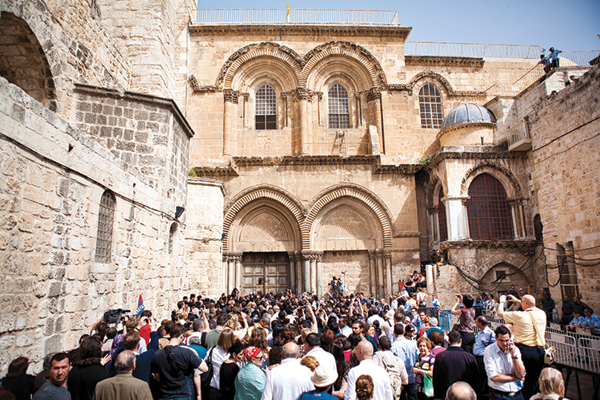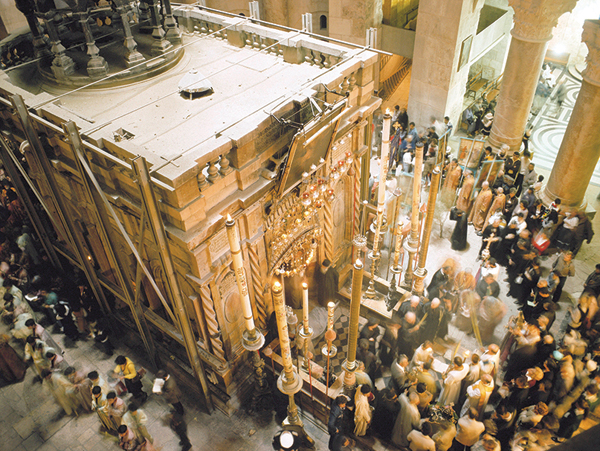Courtesy of VisitPalestine.ps
Via Dolorosa, also known as The Way of the Cross, is located in the Old City of Jerusalem and traditionally follows the steps that Jesus Christ took on his way to Golgotha (Place of the Skull, the site of his crucifixion) and then his burial and resurrection. For centuries, pilgrims have walked the Via Dolorosa every day. With time, the route’s topography has changed with the changing topography of the town, but its spiritual significance remains.
The Via Dolorosa has fourteen stations to commemorate the Passion, death, and resurrection of Jesus. Traditionally, it begins in front of the Madrasa al-Omariya, an Ottoman school building located about 300 meters west of Lion’s Gate. It is believed that here stood the Roman Antonia Fortress where Jesus was sentenced to death.
The Second Station of the Cross marks the spot where Jesus took up the cross. A stone in front of the Church of the Condemnation is thought to mark the beginning of the famous lithostrotos (Greek for pavement), where Pontius Pilate handed down his judgment (John 19:13). Nearby is the Chapel of the Flagellation, built between 1927 and 1929 on the ruins of a Crusader church.
The Third Station marks the spot where Jesus fell for the first time. Immediately after turning left from Via Dolorosa Street onto El-Wad Street, it can be found at the Polish Catholic Chapel, which is so called because it was restored in 1948 by donations from Polish soldiers.
To the right of the Third Station, on El-Wad Street, lies the entrance to the Armenian Catholic Patriarchate and the Church of the Sorrows of Mary. It marks the Fourth Station of the Cross, the place where Jesus met his mother (John 19:26). Above the blue doors of the church can be found an image of the Virgin Mary with Jesus.
Just after turning right back onto Via Dolorosa Road from El Wad Road, lies a Franciscan chapel, built in the nineteenth century, that marks the site where Simon of Cyrene took up the cross for Jesus (Luke 23:26). The station marker “V St” can be found on the brown doors to the left.
Further along Via Dolorosa Street is the Church of St. Veronica that marks the spot where Saint Veronica used her veil to wipe the face of Jesus. The church is cared for by the Little Sisters of Jesus and lies on the site where Veronica is believed to have lived. In 1883, the site was acquired by the Greek Catholic Church.
In the time of Christ, Golgotha was outside the city walls. Traditionally, the Seventh Station commemorates Jesus’ second fall under the weight of the cross. He collapsed when crossing one of the gates leading out of Jerusalem at a place called Gate of Judgment. The outer wall of the Greek Orthodox St. Charambalos Monastery carries a small cross that marks the Eighth Station, traditionally revered as the point where Jesus met the women of Jerusalem who mourned over his destiny (Luke 23:28).
From Souq Khan al-Zeit Street, stairs lead up to the entrance to the Coptic Chapel. A column on the left marks the Ninth Station of the Cross, where Jesus fell for the third time. A gate leads onto the roof of the Church of the Holy Sepulcher and the Ethiopian Monastery.
The remaining stations are located inside the Church of the Holy Sepulcher. The Tenth Station marks where Jesus was stripped of His clothes. Here, visitors can peer into the Latin Chapel through a special window. The Eleventh Station is the site of the crucifixion. On the crest of Golgotha, a Latin shrine marks the spot where Roman soldiers nailed Jesus’ hands and feet to the cross. On Golgotha Calvary, a Greek Orthodox altar marks the Twelfth Station where Jesus died on the Cross. A Franciscan altar marks the Thirteenth Station, the place where Jesus was taken down from the Cross and given to the Virgin Mary. The Fourteenth and final Station of the Cross is the Tomb of Jesus, the site of his burial and resurrection.
\To learn more about Jerusalem and other interesting destinations, visit our website at www.visitpalestine.ps, or contact the Visit Palestine Information Center in Bethlehem via info@visitpalestine.ps or (02) 277-1992.



